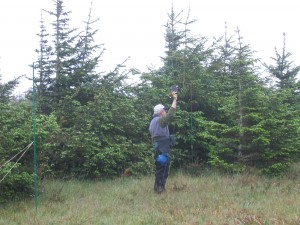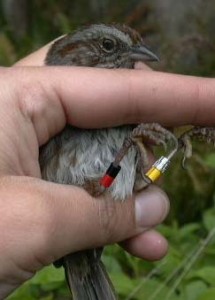A recent post on Cool Green Science about Margaret Morse Nice “How a Scientific Outsider Changed How We Study Birds” inspired me to think more generally about how researchers study bird behavior in the field and how acoustic recordings can help us understand bird behavior. By the way, here “field” does not refer to a type of habitat rather it encompasses any natural habitat (rivers, lakes, meadows, forests etc.) in which animals live.
Margaret Morse Nice’s most important contributions to ornithological research were probably in the advancement of techniques in studying birds. She was one of the few American women ornithologists in the 1930s and the first to make detailed observations of individual birds. She followed Song Sparrows through their lives, took notes on their life history and published her observations in over 200 papers and books. Most of her publications are listed in her autobiography “Research is a passion with me“.
Interestingly, Nice who was born in Massachusetts in 1883 studied Song Sparrows in Columbus, OH where she and her family lived in 1927-1936. During these eight years she closely followed birds on their property off Patterson Ave, a floodplain on the east-side of the Olentangy river just north of Lane Ave, what is today Tuttle park. Even though the habitat has changed from the shrubs, weeds and gardens in Nice’s time you can still find open areas especially along the river which Song Sparrows to this day use to build their nests and raise their young.
To follow individual birds closely, identify them repeatedly and note their behavior and interactions with each other, it was clear to Nice that she needed to mark the birds. Over the years she trapped some 870 Song Sparrows which she marked with unique combinations of plastic color bands on their legs. We still use the same technique today.
Bird banding actually started in Europe as an aid to follow migrating birds and still is used for this purpose: Researchers put a metal band with an engraved unique number on a bird’s leg – just like your social security number. They report this number as well as where and when the bird was caught and banded to a central lab, here in the USA the central bird banding lab in Maryland. When somebody then recaptures or finds a banded bird, they can access this information through the bird banding lab and relate it to data they collect about the bird.
Colored leg bands help researchers to follow individual birds. Sounds easy? It can be once you have the colored leg bands on the bird. First you have to catch the bird and that can prove tricky. We primarily use two established bird trapping techniques: walk-in traps and mist-nets.
Just as the name implies, wire-mesh traps are placed on the ground, seeded with some tasty morsels and when the bird in search of food walks into the trap a door closes behind it and traps it within.
For a mist-net imagine a volleyball net strapped between two poles but with finer mesh and all the way to the ground. These nets work best in foggy weather conditions when they are nearly invisible and when placed strategically in a bird’s flight path, the subject will fly into the mesh, bounce and fall into a fold at the bottom of the net and get entangled. We then “extract” the bird from the net and band it. – By the way not everybody can trap and band birds because they are highly protected under the Migratory Bird Treaty Act dating back to 1918. Through training with a master bird bander researchers can obtain a U. S. Federal Bird Banding and Marking Permit.
So what role does sound play in this? Sometimes we lure birds to the mist-net by playing calls or songs of its species. Why does this attract a bird? Most songbirds are territorial, i.e. they defend an area that they use exclusively for feeding or breeding and song keeps every other bird of the same species out of this territory. Some researchers have actually done clever experiments to prove this keep-out function of birdsong, but that is a story for another post.

Doug Nelson holding up a loudspeaker playing bird song in front of a mist-net in Oregon (c) Angelika Nelson
So, birds do not produce their most beautiful songs to please us, rather one function is to repel a male contender. If the opponent does not take this warning, a bird will switch to physical attack. Exactly this behavior can get them trapped in a mist-net as they search intently for the invisible opponent, aka loudspeaker, and eventually dive at in attack.
This brings me back to Nice’s contributions to field ornithology: Nice studied closely the territorial behavior of “her” birds. Once all males were banded she made close observations of where they sang, how they interacted with neighbors and whether they were able to attract a mate. She described patterns of invaders and defenders during territorial encounters and described the role that song played in these. To this day this is a prominent research topic in our lab where we have studied territorial singing behavior in the White-crowned Sparrow and other species over the last decades.
Following in the footsteps of Margaret Morse Nice, Dr. Chris Tonra, Assistant Professor in the School of Environmental and Natural Resources at Ohio State, has started a project to continue work on behavior of the Song Sparrow. He and his students regularly band today’s local Song Sparrow population at Ohio State’s Wilma H. Schiermeier Olentangy River Wetland Research Park, less than one km upstream from Nice’s former home, and follow them throughout the year. He uses some of the techniques from Nice’s days, others have advanced – read more about the project here!
About the author: Angelika Nelson is the curator of the Borror Laboratory of Bioacoustics. Her recent research has focused on song and behavioral ecology of the White-crowned Sparrow in Oregon; each spring Angelika teaches the OSU course “Ohio Birds” where students learn about the life of birds and how to identify them in the field – by sight and sound.
References:
“Nice, Margaret Morse.” Complete Dictionary of Scientific Biography. 2008. Encyclopedia.com. (August 17, 2016).




I enjoy the excitement of their daily challenges. Pututogel